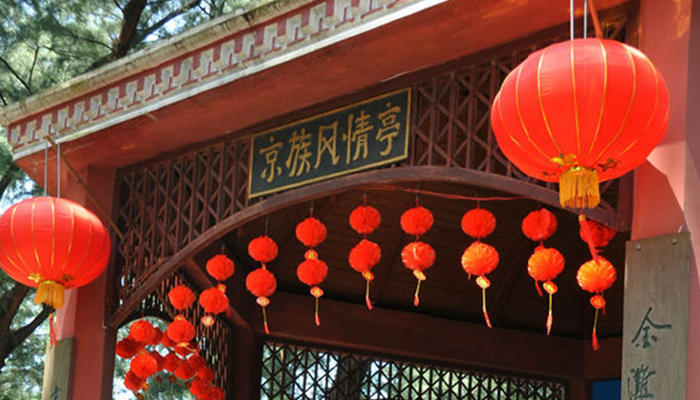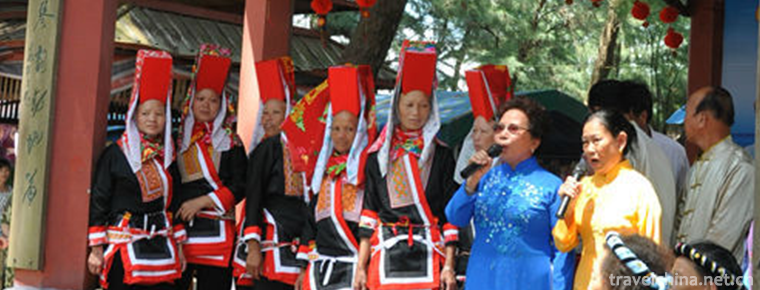Kazakhstan Jing nationality Ha festival
Kazakhstan Jing nationality Ha festival
Kazakhstan Festival, also known as "Singing Kazakhstan Festival", the so-called "Kazakhstan" or "Singing Kazakhstan" means singing. It is a traditional festival of the Jing nationality and one of the national intangible cultural heritages.
Kazakhstan Festival is mainly popular in the residential areas of the Jing nationality in Guangxi. The dates of Kazakhstan Festival vary from place to place. Wanwei and Wutou islands are on the tenth day of June, Shanxin islands are on the tenth day of August, and some villages on the coast are on the 25th day of the first month. Although the dates vary, the forms and contents of festivals are basically the same. Kazakhstan Festival is the most solemn festival of the Jing nationality, also known as "Singing Kazakhstan Festival". "Kazakhstan" is a transliteration of Beijing dialect, which contains the meaning of "song". The festivals of Kazakhstan are different from place to place, either on the tenth day of June, on the tenth day of August, or on the fifteenth day of the first month of the lunar calendar. Everywhere there is a special building for Kazakhstan Festival activities - Harting. The Kazakhstan Festival of the Jing nationality consists of ancestor worship, local drinking, social intercourse and entertainment.
On May 20, 2006, the Kazakhstan Festival declared by Dongxing City, Guangxi Zhuang Autonomous Region, was approved by the State Council and listed in the first batch of national intangible cultural heritage list (category: folklore; number: _-7).
historical origin
There are many folklores about the historical origin of Kazakhstan Festival, among which there are representative legends: in ancient times, a song fairy came to the three islands of the Jing nationality to mobilize the masses to resist the feudal oppression in the name of passing songs. Her singing touched many people. In order to commemorate her, later generations established the "Harting" and regularly sang songs in Harting, gradually becoming a festival custom. Harting in each village is the center of festival activities.
Another said that four or five hundred years ago, there was a huge centipede spirit under Bailong Ridge on the coast of Beibu Gulf. It eats human beings. Every ship passing by in the sea from now on must be given a living person to eat it, otherwise it will overturn, causing people's wives to be separated and restless. Once a God knew it, he came here to wipe out harm for the people. When the centipede came to the entrance of Jingdong, the immortal stuffed the hot pumpkin into the centipede's mouth, and the centipede swallowed the big pumpkin. The centipede swallowed the big pumpkin, burned it, and the corpse was cut off three times, and then drifted along with the waves to become ten thousand tails, Wushan, Shanxin "three islands of the Jing nationality", and the residents nearby could live and work in peace and contentment. So the Jing people worship the immortals as "the great king of Zhenhai". They set up temples to offer sacrifices to him. Every year they go to the seaside to welcome the "great king of Zhenhai" to enjoy sacrifices, which becomes the annual Hakka Festival.
Distribution range
The Jing people mainly live on Wanwei, Wutou and Shanxin islands in Dongxing City, Guangxi Zhuang Autonomous Region. They are located in the southwest part of the coastline of the mainland of China and are across the sea from Vietnam.
Inheritance and protection
Inheritance value
Kazakhstan Festival is the only national traditional festival of the Jing nationality. Every year, Chongqing is celebrated with the main contents of sacrificing gods, reuning villagers and communicating and entertaining. After nearly 500 years of development and evolution, the Kazakh Festival of the Jing Nationality is a concentrated reflection of the traditional culture of the Jing Nationality. Through understanding the whole process of greeting, offering sacrifices to gods, singing, drinking and delivering gods on the Ha Festival of the Jing nationality, we can understand that the Ha Festival is the accumulation of marine culture.
The dancing forms of the Jing nationality are relatively few, mainly concentrated in the sacrificial rites of the Hakka Festival. The dance in Kazakhstan Festival is a representative traditional dance of the Jing nationality. With its unique form, rich connotation and primitive style, Kazakhstan Festival dance vividly demonstrates the long history, unique living customs, stable psychological state and colorful cultural style of the Jing nationality. Kazakhstan Festival dance embodies the essence of the national culture of the Jing nationality. Its dance style is the concentrated reflection of many cultural phenomena formed in the long history of the Jing nationality.
protective measures
On May 20, 2006, it was published as the first national intangible cultural heritage list by the State Council. In December 2010, Fangchenggang was selected as the first group of municipal intangible cultural heritage projects.
In 2009, the Beijing Ha Festival and the Beijing Zinan Cultural Heritage Research Center were officially launched in Fangchenggang City, Guangxi on 29 th. The main task of the research center is to protect and inherit the national intangible cultural heritage - the Ha Festival of the Jing Nationality and the Zinan Culture of the Jing Nationality.
social influence
As a unique minority in Guangxi, the Jing nationality has its own unique national culture. The cultural characteristics of the Jing nationality are mainly embodied in its folk rituals. As the most important festival of the Jing nationality, Kazakhstan Festival embodies the Jing culture including belief, belief, spirit and emotion, as well as the music and dance art of the Jing nationality. The Hakka Festival of the Jing Nationality lasts for several days, and its ceremonies are different and specific, with exquisite forms and grand scenes. It fully expresses the emotional characteristics and fate of the Jing people. In addition, Vietnamese Vietnamese also have some people to attend (Vietnamese Vietnamese held Kazakhstan Festival, some of the Jing people were invited to attend).



-
1.Shennong Creek Scenic Area
Shennongxi, originating from the main peak of Shennongjia, flows through Badong County, Hubei Province. It travels from north to south through deep mountain canyons, and converges into the Yangtze Riv
Time 2018-12-12 -
2.Mupa Mipa
Mupa Mipa, a local traditional folk literature in Simao City, Yunnan Province, is one of the national intangible cultural heritage.
Time 2018-12-15 -
3.Wuyuezhai Scenic Area
Wuyuezhai Scenic Area, National Forest Park, AAAAAA Tourist Area, is located in the eastern foot of Taihang Mountain, located in the northwest of Lingshou County, Hebei Province
Time 2018-12-22 -
4.Qinghai Kekexili National Nature Reserve Hoh Xil
The Kekexili National Nature Reserve in Qinghai Province is located in the western part of Yushu Tibetan Autonomous Prefecture with a total area of 4.5 million hectares
Time 2019-01-29 -
5.Shantou Fangte Happy World Blue Mercury Theme Park
Shantou Fangte Happy World Blue Mercury Theme Park is the first participatory high-tech theme park in eastern Guangdong with science fiction as its theme, integrating entertainment,
Time 2019-02-08 -
6.Traditional Processing Techniques of Liuweizhai Sauced Meat
Liuweizhai is a well-known Chinese brand which was founded in 1738 in the three years of Qianlong in Qing Dynasty. Its sauced meat, as a traditional food in China and a famous food in the Three Jin Dy
Time 2019-05-14 -
7.Construction Techniques of Tujia Diaojiao Building
Tujia hanging-feet building construction skills, Hubei Xianfeng County, Hunan Yongshun County, Chongqing Shizhu Tujia Autonomous County, local traditional skills, one of the national intangible cultur
Time 2019-06-23 -
8.Ningbo Opera
Yong Opera is a local opera sung in Ningbo dialect of Zhejiang Province. Its musical tone belongs to Tanhuang. After 1938, this opera genre was officially called "Yongju" or "improved Y
Time 2019-07-14 -
9.Anhui University Of Traditional Chinese Medicine
Anhui University of Chinese Medicine is located in Anhui. Jiangnan Labial teeth, Huai right A famous historical and cultural city called "the throat". Hefei For Anhui higher education revita
Time 2019-11-07 -
10.Cultural undertakings in Panzhihua
As of the end of 2018, Panzhihua has 3 museums and exhibition halls; 50 cultural (Art) museums, including 44 cultural stations and 8 theatres and cinemas; and 6 public libraries, with a total collection of 990800 books. There are 43 Township radio and television stations and
Time 2020-12-14 -
11.Neijiang traffic
Neijiang has convenient transportation, which is one of the main national highway transportation hubs planned by the Ministry of transport, the second largest transportation hub in Sichuan Province and an important intersection point of Southwest land
Time 2020-12-16 -
12.Meishan secondary industry
By the end of 2019, there were 596 Industrial Enterprises above Designated Size, and the added value of industries above designated size increased by 9.8%. In the whole year, 82 kinds of products from industries above Designated Size participated in the statistics,
Time 2020-12-18